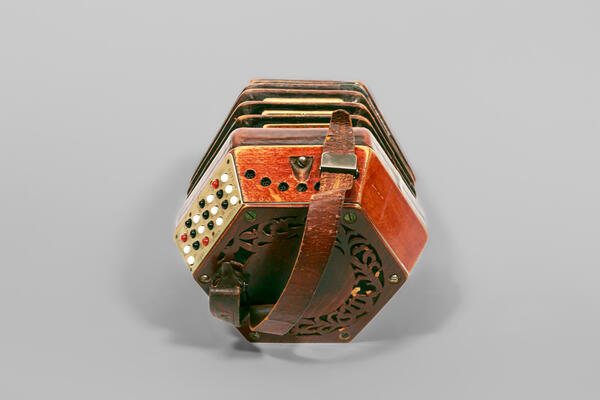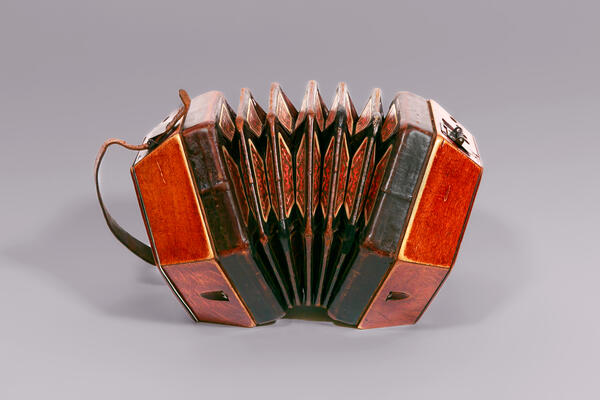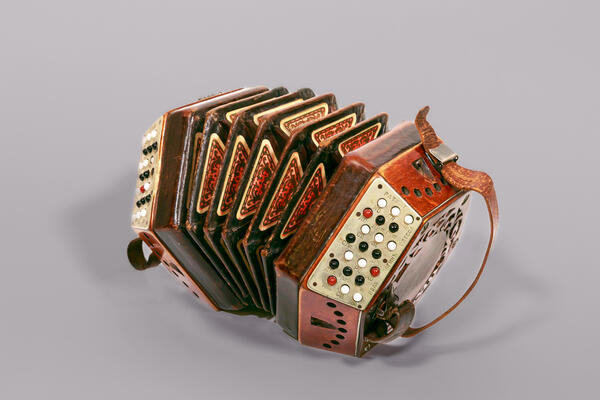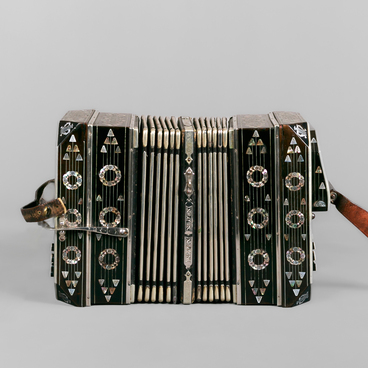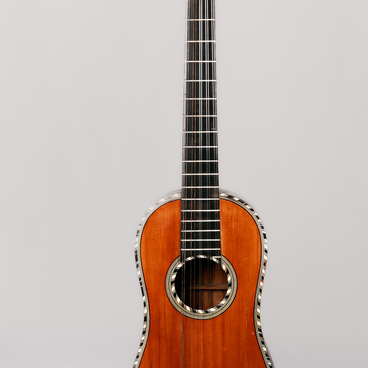In the late 19th century, the production of Russian concertinas, known as melo-harmonicas, was organized in Odessa. These instruments were manufactured in the workshops of Ivan Blagin and Yefim Nikolayev. The masters were celebrated for the unique simple design of their instruments, the fine craftsmanship, and the benefits of introducing melo-harmonicas into choir practice. They received awards at the world fairs in Paris in 1899, Chicago in 1893, and Antwerp in 1894.
The most famous melo-harmonica craftsman was Ivan Blagin. He was skilled at playing the concertina and other free-reed instruments and could read sheet music. He was often contacted by artists and circus performers from other regions. Ivan Blagin designed a new Russian concertina with a unique design and keyboard layout that he named “the blaginton.”
Like a concertina, the blaginton from the museum’s collection has a hexagonal shape, but its sides are truncated. On both ends, the instrument has 21 buttons (for each hand). The notes belong to a chromatic scale. The name of the note is written below each button. The white buttons correspond to the white piano keys, while the black buttons correspond to the black piano keys that are used to identify sharps or flats. The tone of the instrument does not depend on whether the bellows are pushed or pulled.
The craftsman spent almost 30 years manufacturing blagintons, but only a few of them have survived to this day. This blaginton was inherited by Blagin’s great-granddaughter Valentina Chernikova. In 2006, she donated the instrument to the museum. According to her, Ivan Blagin made this concertina presumably in 1906–1908 for Tsesarevich Alexei, the son of Emperor Nicholas II. She also said that the craftsman himself taught Tsesarevich how to play this instrument.
After Blagin’s death, his wife kept the concertina as a remembrance of the imperial family and her husband’s work. The blaginton was handed down from generation to generation. Valentina Chernikova told the following story about the instrument, “During the Great Patriotic War, when the German army came close to Odessa, my grandmother buried the blaginton in our garden and planted a birch tree above that place so that it would be easier to find the instrument later.” Their family left Odessa, and when they came back after the war, they were able to find the hidden instrument. Many years later, it entered the museum’s collection together with a medallion of Tsesarevich Alexei.
The most famous melo-harmonica craftsman was Ivan Blagin. He was skilled at playing the concertina and other free-reed instruments and could read sheet music. He was often contacted by artists and circus performers from other regions. Ivan Blagin designed a new Russian concertina with a unique design and keyboard layout that he named “the blaginton.”
Like a concertina, the blaginton from the museum’s collection has a hexagonal shape, but its sides are truncated. On both ends, the instrument has 21 buttons (for each hand). The notes belong to a chromatic scale. The name of the note is written below each button. The white buttons correspond to the white piano keys, while the black buttons correspond to the black piano keys that are used to identify sharps or flats. The tone of the instrument does not depend on whether the bellows are pushed or pulled.
The craftsman spent almost 30 years manufacturing blagintons, but only a few of them have survived to this day. This blaginton was inherited by Blagin’s great-granddaughter Valentina Chernikova. In 2006, she donated the instrument to the museum. According to her, Ivan Blagin made this concertina presumably in 1906–1908 for Tsesarevich Alexei, the son of Emperor Nicholas II. She also said that the craftsman himself taught Tsesarevich how to play this instrument.
After Blagin’s death, his wife kept the concertina as a remembrance of the imperial family and her husband’s work. The blaginton was handed down from generation to generation. Valentina Chernikova told the following story about the instrument, “During the Great Patriotic War, when the German army came close to Odessa, my grandmother buried the blaginton in our garden and planted a birch tree above that place so that it would be easier to find the instrument later.” Their family left Odessa, and when they came back after the war, they were able to find the hidden instrument. Many years later, it entered the museum’s collection together with a medallion of Tsesarevich Alexei.

